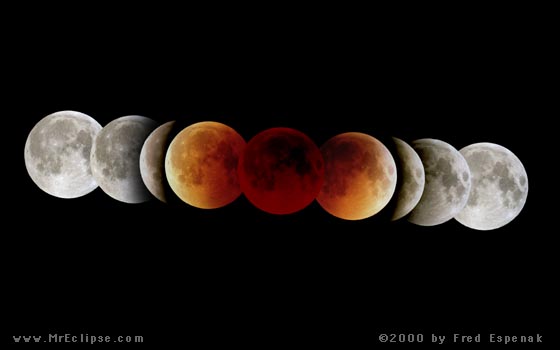Credit & Copyright: Fred Espenak
(courtesy of
www.MrEclipse.com)
Explanation:
The
first eclipse of the third millennium is coming up!
A total lunar eclipse mainly
visible from
Europe, Asia, and Africa,
will occur on January 9th as the
full Moon glides through the long,
but not so dark shadow of
planet Earth.
Why not so dark?
Sunlight is actually scattered and refracted into
Earth's shadow
by the atmosphere, a circumstance which can help create some
striking photographs of the eclipsed Moon.
For example, this image is a composite of photographs taken during
the July 2000 total lunar eclipse.
Early and late phases of the eclipse flank a
deep
exposure made during totality.
The feeble sunlight still shining on the lunar surface gives the
moon a dramatic dark red cast.
While the
July
2000 eclipse
was not the first or last of any
millennium, it was remarkable for being the longest eclipse
for about the next 1,000 years,
totality lasting an impressive one hour and 47 minutes.
Totality for the January 9th eclipse will last just over one hour.
1999 2000 2001 2002 2003 2004 2005 2006 2007 2008 2009 2010 2011 2012 2013 2014 2015 2016 2017 2018 2019 2020 2021 2022 2023 2024 2025 |
Январь Февраль Март Апрель Май Июнь Июль Август Сентябрь Октябрь Ноябрь Декабрь |
NASA Web Site Statements, Warnings, and Disclaimers
NASA Official: Jay Norris. Specific rights apply.
A service of: LHEA at NASA / GSFC
& Michigan Tech. U.
|
Публикации с ключевыми словами:
лунное затмение - eclipse - lunar eclipse - millennium
Публикации со словами: лунное затмение - eclipse - lunar eclipse - millennium | |
См. также:
Все публикации на ту же тему >> | |
